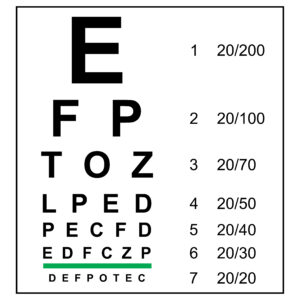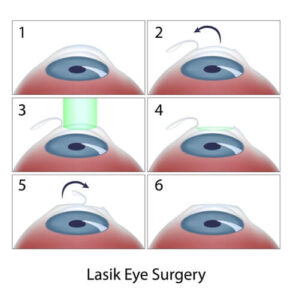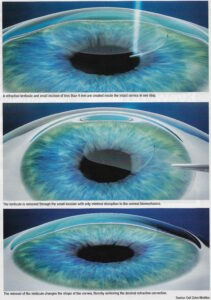Posted by: Manhattan LASIK Center
Most people have heard the term 20/20 vision, but fewer know what having 20/20 means. Many people assume that if you have 20/20 vision, it’s a sign that you have the best possible or “perfect” eyesight attainable.
If you have refractive errors like nearsightedness, farsightedness, or astigmatism, it means you have a misshapen cornea. A cornea that’s an irregular shape affects your ability to see clearly when you don’t wear prescription glasses or contact lenses.
But did you know that most people with a refractive error can achieve 20/20 vision? All it takes is a low-risk refractive laser eye procedure.
These procedures may include LASIK or SMILE. Both can help you achieve visual freedom. There’s also a good chance you’ll end up with 20/20 vision or better after undergoing them.
But what exactly is 20/20 vision, and how can refractive laser eye procedures like LASIK and SMILE help you achieve it? Keep reading to learn more about 20/20 vision and how improving your vision can change your life!
Visual Acuity

Visual acuity is a term that refers to how well you can see. Baseline, normal visual acuity is 20/20.
When you have 20/20 vision, someone with normal vision can see an object 20 feet away. They can see this object as it’s supposed to be seen at that distance.
If you have refractive errors, it skews your visual acuity. You may not be able to see an object at 20 feet the same way someone with normal visual acuity would.
In that case, your visual acuity may be something like 20/40. With this visual acuity, you’d see an object 20 feet away from you the same way someone with normal vision would see it at 40 feet.
If you’re nearsighted especially, you’re likely to have a visual acuity with a much higher number after the 20/. Even 20/40 vision is considered to be close to having normal vision.
Your best-corrected visual acuity must be 20/70 or worse to be considered visually impaired. That means you can only correct your vision to 20/70 with traditional visual aids like contacts or glasses.
However, many people can achieve their best-corrected visual acuity of 20/20 even if they have a refractive error. But that only means your vision is 20/20 if you wear contacts or glasses.
Sometimes, glasses and contacts can only get you close to 20/20 vision. But there is a way for most people to achieve 20/20 vision without contact lenses or glasses, and that’s by undergoing a laser vision correction procedure.
Laser Vision Correction Procedures

Refractive laser vision correction procedures change the way light refracts through your eye. When you have a refractive error, it’s due to the shape of your cornea, which is the clear, front part of your eye.
When light passes through the cornea, it refracts before hitting your retina, creating a focal point on your retina. Light doesn’t refract correctly if your cornea has abnormalities in its shape, hitting its focal point in front or behind the retina.
These abnormalities cause images to appear blurry if they’re too far away, too close, or in the case of astigmatism, at all distances.
Using lasers, laser vision correction procedures reshape your cornea to correct these abnormalities. Doing so can not only give you 20/20 vision, but it may give you even better than 20/20 vision.
Having better than 20/20 vision means you can see objects at a farther distance at the same clarity as someone would see at 20 feet. For example, if your visual acuity is 20/15, you can see as well at twenty feet as people with normal vision can at 15 feet.
At Manhattan LASIK Center, we offer LASIK and SMILE, two different kinds of laser vision correction procedures. Although they share some similarities, they are two distinctly different vision correction procedures.
LASIK and SMILE

LASIK is an immensely popular procedure and with good reason. The laser vision correction procedure has excellent outcomes, with over 95% of patients achieving 20/20 vision or better.
The procedure can correct nearsightedness, farsightedness, and astigmatism. But a crucial factor for its success is that patients need thick enough corneas.
If your corneas aren’t thick enough, getting LASIK can become unsafe. It may also mean you can’t achieve the results you want.
LASIK involves creating a flap in the cornea and then using a laser to reshape the tissue underneath. If your cornea is too thin to create the flap during LASIK, you won’t qualify as a LASIK candidate.
SMILE

SMILE is a procedure much like LASIK, but it only corrects nearsightedness and astigmatism. It’s the most advanced third-generation laser vision correction procedure.
Unlike LASIK, SMILE doesn’t involve creating any flaps in the cornea. Instead, it only uses a femtosecond laser, leaving the surface of your eye untouched.
It uses a femtosecond laser to create a disc shape (called a lenticule) below your cornea’s surface and then remove it through a tiny incision. The small incision heals within a few days, making the recovery from SMILE even easier than LASIK.

SMILE also has similar outcomes to LASIK, with the vast majority of patients achieving 20/20 vision or better. 90% of patients that get SMILE achieve 20/20 vision or better.
SMILE creates a 4-millimeter incision that’s 80% smaller than the flap created during LASIK. With a smaller incision, SMILE leaves the cornea stronger and reduces the chances of dry eye syndrome. You can look forward to clearer vision, sharper visual acuity, and a world that opens up to you after having SMILE.
If you want your best visual acuity, refractive laser eye surgery is the way to go! Schedule a consultation today at Manhattan LASIK Center in Westchester, NY, to find out which procedure is best for you. Isn’t it time to invest in your best vision?

